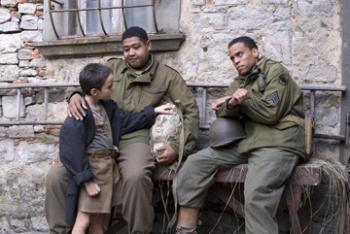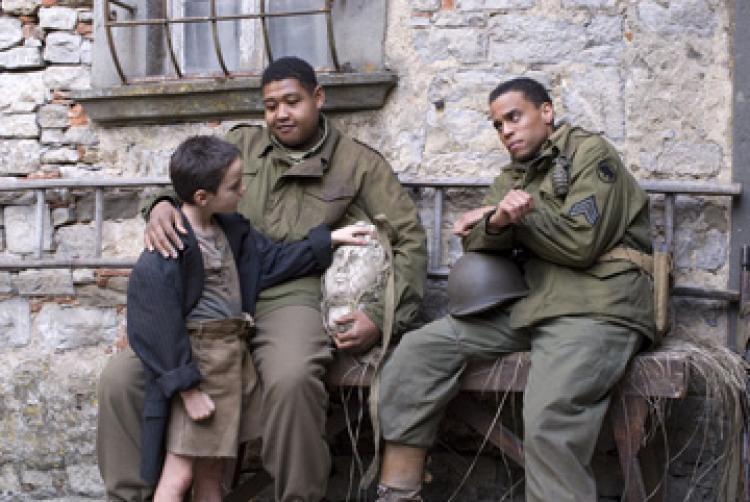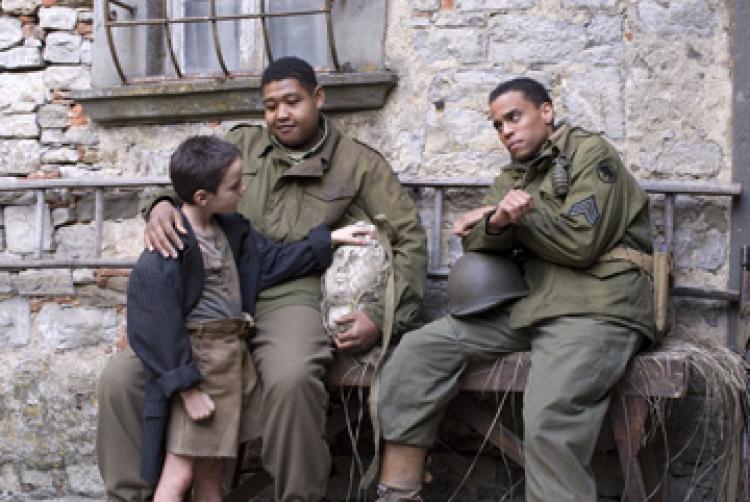The name Spike Lee tends to bring on quick reactions from movie aficionados. Some love his films, some hate them. Yet despite any of the judgments that others might have, his films shed light on racial and prejudicial issues which would never become part of the mainstream psyche if he wasn’t around making films. Lee has self-dubbed his films to date as Spike Lee “Joints.”
Yet, his most recent film, Miracle at St. Anna, which opens this weekend in L.A. and New York, and the nationwide next weekend, stands in contrast, as a Spike Lee film. And after watching, I can understand why.
While the film does bear the “joint” like aspects of tackling racial issues, it’s far more a film about humanity and their characters than any other Spike Lee films of the past. It truly bears the moniker of a Spike Lee “Film.”
Based on the novel of the same title by James McBride, Miracle at St. Anna is a story of four African American soldiers in the 92nd Infantry Division who are amidst the conflict against the Nazi’s near Tuscany, Italy.
The film begins in present day with the character Hector Negron, an elderly African American shooting an Italian man who approaches his U.S. postal counter requesting stamps. Negron, played by newcomer Laz Alonso, pulls out a gun and shoots the man point blank. He remains in police custody, refusing to speak, until a news reporter asks him questions that lead to a flashback to Negron’s tour during World War II with three other African American soldiers.
After getting separated from their unit, Sgt. Aubrey Stamps played by Derek Luke (Antoine Fischer), leads Negron and the other two soldiers—Sam Train played by Omar Benson Miller, and Sgt. Bishop Cummings played by Michael Ealy—into a small Tuscan town, where they stumble upon a young Italian orphan boy who appears to have magical powers. Train, a big, yet gentle character begins a fatherly like relationship with the boy, who speaks only Italian.
As the group attempt to avoid crossing paths with the Nazi’s hiding out in the town, Train carries around the head of a statue from a fallen Italian bridge. He uses the statue as a good luck charm, a plot vehicle which will drive you back to the future with Negron at present day.
While the transitions of the film to the days of World War II could have been more fluid, and the running time of 160 minutes means you will likely get stiff in the theater, there is no denying this is Spike Lee’s best film yet. It tackles the issues of race during World War II while the dramatic scenes between Omar Benson Miller and the young Matteo Sciabordi are as hearfealt as they come.
I wouldn’t be surpised to see a Best Supporting Actor Nomination for Miller come Oscar time, and Spike’s Academy Award chances do not get any better. If you are usually averse to Spike Lee’s movies, chuck the notion aside for Miracle at St. Anna for it is a ‘Spike Lee Film’ that is a must see.
Yet, his most recent film, Miracle at St. Anna, which opens this weekend in L.A. and New York, and the nationwide next weekend, stands in contrast, as a Spike Lee film. And after watching, I can understand why.
While the film does bear the “joint” like aspects of tackling racial issues, it’s far more a film about humanity and their characters than any other Spike Lee films of the past. It truly bears the moniker of a Spike Lee “Film.”
Based on the novel of the same title by James McBride, Miracle at St. Anna is a story of four African American soldiers in the 92nd Infantry Division who are amidst the conflict against the Nazi’s near Tuscany, Italy.
The film begins in present day with the character Hector Negron, an elderly African American shooting an Italian man who approaches his U.S. postal counter requesting stamps. Negron, played by newcomer Laz Alonso, pulls out a gun and shoots the man point blank. He remains in police custody, refusing to speak, until a news reporter asks him questions that lead to a flashback to Negron’s tour during World War II with three other African American soldiers.
After getting separated from their unit, Sgt. Aubrey Stamps played by Derek Luke (Antoine Fischer), leads Negron and the other two soldiers—Sam Train played by Omar Benson Miller, and Sgt. Bishop Cummings played by Michael Ealy—into a small Tuscan town, where they stumble upon a young Italian orphan boy who appears to have magical powers. Train, a big, yet gentle character begins a fatherly like relationship with the boy, who speaks only Italian.
As the group attempt to avoid crossing paths with the Nazi’s hiding out in the town, Train carries around the head of a statue from a fallen Italian bridge. He uses the statue as a good luck charm, a plot vehicle which will drive you back to the future with Negron at present day.
While the transitions of the film to the days of World War II could have been more fluid, and the running time of 160 minutes means you will likely get stiff in the theater, there is no denying this is Spike Lee’s best film yet. It tackles the issues of race during World War II while the dramatic scenes between Omar Benson Miller and the young Matteo Sciabordi are as hearfealt as they come.
I wouldn’t be surpised to see a Best Supporting Actor Nomination for Miller come Oscar time, and Spike’s Academy Award chances do not get any better. If you are usually averse to Spike Lee’s movies, chuck the notion aside for Miracle at St. Anna for it is a ‘Spike Lee Film’ that is a must see.






